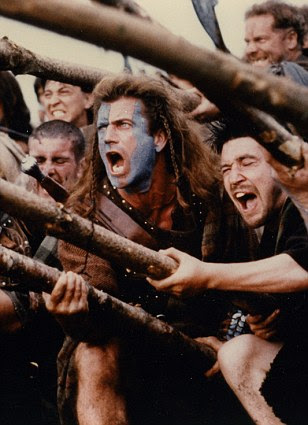The Vikings Reached North America Before Columbus

Photo: Universal History Archive/UIG via Getty Images
Nearly 500 years before Christopher Columbus ever sailed the ocean blue, the first Europeans to ever step foot in North America was a group of Vikings led by Leif Eriksson. Lief Eriksson’s own father, Erik the Red was a famous traveler before his son, establishing the first European settlement of Greenland. Supposedly, Erik the Red had also sailed from Iceland to Canada and encouraged his on Leif to explore new lands as well.
This led to Leif eventually discovering North America although he made no moves to take over the land or attack the Native American’s. For the most part, the Viking discovering of North America remained unknown long after Christopher Columbus took the credit as the first European.

Photo: CARL DE SOUZA/AFP/Getty Images
While for the most part, Vikings were very concerned with their hygiene and overall cleanliness, they seemed to put that all aside when it came to lighting fires. Their process would begin with collecting torchwood fungus from tree bark and then boiling it for several days in human urine. They would then pound the soaked bark it into a felt-like substance that was easy to transport and durable.
They had discovered that the sodium nitrate in urine would allow the material smolder and not just burn, allowing them to travel vast distances and start a new fire on the go. Not the first thing that comes to mind when starting a fire but the Vikings figured it out.

Photo: History Channel
Contrary to popular belief, Vikings didn’t just go around settling things on their own. In reality, they had an established justice system in order to resolve any disputes or crimes that came up. Norse culture knew this system as “Althing,” translated to mean “The Thing.”
Regularly, “The Thing” was held and a law speaker would hear people’s disputes. They would then settle these disputes either through peaceful means, usually done with the help of an objective third party, much like our court system today. However, in some cases, justice was decided through violence and occasional execution.
It’s easy to forget that Vikings were more than just raiders.

Photo: Pinterest
Tattooing has been proven to have existed well before the Vikings,yet that doesn’t necessarily mean that Vikings had tattoos. Although people today demonstrate their Viking heritage by getting “traditional” Viking tattoos, it’s still not clear if real Vikings had these tattoos or if they are just ancient Norse symbols.
While in television and movies Vikings are often depicted as covered in tattoos, there still is no physical evidence that they practiced the art. Furthermore, considering that the Viking’s took pride in their cleanliness and were even a little obsessive about it, it may seem likely that they didn’t want to cover their skin with permanent markings.

Photo: History Channel
Although Viking men and women may not have been treated as equals, they certainly had more rights than other groups of women around the world. While they often were married around 12, expected to carry out motherly and wifely duties, they did have some basic rights and freedoms. These included having the right to inherit property, file for divorce, and even reclaim settlements if the marriage failed.
Although Viking males were the “man of the house,” the women controlled the entire domestic sphere. If her husband died, she inherited all of the responsibilities and roles that were once her husbands. Although it wasn’t all that common, there are also stories and legends of female warriors known as “shieldmaidens” that fought alongside Viking men.
Vikings Preferred Having Blonde Hair

Photo: Pinterest
While most of the popular culture surrounding Vikings depicts them with blonde hair, that is something that they got right. For whatever reason, Vikings preferred the look of blonde hair and even based their definition of beauty around having it.
So, those that were born without blonde hair created a process in order to achieve the beloved color. They would use a strong soap that had a high lye concentrate in order to bleach their hair. On occasion, some Viking men would even bleach their beards to in order to have as much blonde visible as possible.

Photo: Universal History Archive/UIG via Getty Images
Considering that the majority of life revolved around the ocean whether it be seafaring, raiding, or fishing, it was only appropriate that their burials would involve a boat. In the Norse religion, it was believed that great warriors would need a vessel to cross over into the afterlife and reach Valhalla. So, prominent Vikings and exceptional women would have the honor of being laid to rest in a traditional Viking ship.
Along with the body, the ship would be filled with weapons, food, treasure, and anything else they may need in the afterlife. In some occasions, slaves were even sacrificed and put on the boat as well to serve their masters in the afterlife.
They Never Wore Horned Helmets

Photo: Fine Art Images/Heritage Images/Getty Images
One of the biggest misconceptions about the Vikings was that they wore horned helmets into battle. However, this has been proven to be completely false. If they wore helmets at all in combat, they certainly didn’t have horns on them because there have been no artifact discovered to suggest this was something that Vikings wore.
The idea behind the horned helmets came from the Victorian era to romanticize the image of the Vikings. They were described as wearing these scary-looking helmets in order to make them seem as savage and horrifying as possible.
The Days Of The Week Are Named After Viking Gods

Photo: DeAgostini/Getty Images
Unknown to many people, the Norse gods worshipped by the Vikings are a part of our everyday lives. The days of the week are actually references to the names of specific gods. The great raven god Odin, also known as Woden, is now Wednesday, which literally means Woden’s Day. Tuesday and Friday are named after Tyr and Frigg, the god and goddess of war and marriage.
The most famous, is Thor, the god of thunder and strength, for Thursday. While much of Viking culture may be lost, it’s interesting that something as fundamental as the days of our modern week can be directly traced back to their belief system.
Vikings Weren’t As Giant As They Are Depicted

Photo: Universal History Archive/UIG via Getty Images
Vikings are commonly depicted as being giant, muscular men with the ability to kill their enemies with one swing of an ax, however, that’s an over-exaggeration. They didn’t look like Rollo from the History Channel show Vikings or Chris Hemsworth in Thor. They were typically around 5 feet 7 inches and were leaner than they were burly.
Their size has been explained by their summer seasons being exceptionally short, leading to fewer resources and therefore less food. This lack of good weather is also what led the Vikings to go on raids in order to take other’s resources. Much like with the horned helmets, the description of the Vikings as being large was a way to make them seem much scarier than they were and paint them as almost inhuman.
The Viking Afterlife

Photo: DEA / G. DAGLI ORTI/De Agostini/Getty Images
Though many modern religions believe in some form of heaven and hell, the Vikings had a totally different view of the afterlife. They thought that the way you lived life would dictate which of several afterlife realms you would go to after death. For the Vikings, the best place you could hope to go to was Valhalla.
This place was reserved for warriors that fought bravely and died bravely in battle. Next was Helgafjell, another place for admirable people that lived a fulfilling life. Hellheim, on the other hand, was a place for dishonorable people who didn’t die well, this could even mean dying comfortably of old age.
|





















































 On 11th September Wallace and Murray achieved a stunning victory at the Battle of Stirling Bridge. The English left with 5,000 dead on the field, including their despised treasurer, Hugh Cressingham, whose flayed skin was taken as a trophy of victory and to make a belt for Wallace’s sword. The Scots suffered one significant casualty, Andrew Murray, who was badly wounded and died two months later.
On 11th September Wallace and Murray achieved a stunning victory at the Battle of Stirling Bridge. The English left with 5,000 dead on the field, including their despised treasurer, Hugh Cressingham, whose flayed skin was taken as a trophy of victory and to make a belt for Wallace’s sword. The Scots suffered one significant casualty, Andrew Murray, who was badly wounded and died two months later.












































No comments:
Post a Comment